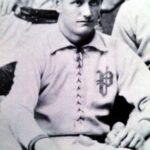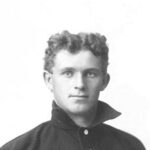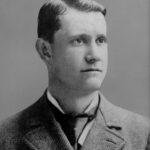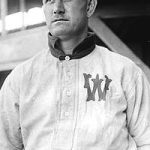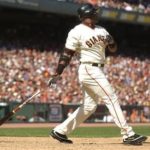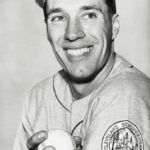Ed Delahanty Stats & Facts
Ed Delahanty
Positions: Leftfielder, First Baseman and Second Baseman
Bats: Right • Throws: Right
6-1, 170lb (185cm, 77kg)
Born: October 30, 1867 in Cleveland, OH
Died: July 2, 1903 in Niagara Falls, Canada
Buried: Calvary Cemetery, Cleveland, OH
Debut: May 22, 1888 (1,269th in MLB history)
Last Game: June 25, 1903
Hall of Fame: Inducted as Player in 1945. (Voted by Old Timers Committee)
No induction ceremony in Cooperstown held (until 2013).
View Ed Delahanty’s Page at the Baseball Hall of Fame (plaque, photos, videos).
Full Name: Edward James Delahanty
Nicknames: Big Ed
View Player Bio from the SABR BioProject
Relatives: Brother of Frank Delahanty, Jim Delahanty, Joe Delahanty, Tom Delahanty
Nine Players Who Debuted in 1888
Ed Delahanty
Billy Hamilton
Jake Beckley
Cupid Childs
Hugh Duffy
Kid Gleason
Frank Dwyer
Billy Hoy
Duke Farrell
The Ed Delahanty Teammate Team
C: Jack Clements
1B: Roger Connor
2B: Nap Lajoie
3B: Bill Coughlin
SS: Lave Cross
LF: Billy Hamilton
CF: Elmer Flick
RF: Sam Thompson
SP: Tim Keefe
SP: Kid Carsey
SP: Al Orth
SP: Red Donahue
M: George Stallings
Notable Events and Chronology for Ed Delahanty Career
Biography
The greatest natural hitter of his time, Ed Delahanty is considered by many baseball historians to be the greatest righthanded batter to play in the major leagues prior to Rogers Hornsby. An extraordinary batsman who surpassed the .400-mark three times during his career, Delahanty posted the fifth highest lifetime batting average in history, a mark of .346 that places him behind only Ty Cobb (.367), Hornsby (.358), Shoeless Joe Jackson (.356), and Lefty O’Doul (.349) in the all-time rankings. Blessed with outstanding power as well, Delahanty once hit four home runs in a game, and he is the only player in baseball history with a four-homer game to his credit to also have a game in which he hit four doubles. Delahanty also remains the only player to win a batting title in both major leagues. The outfielder’s tremendous on-field accomplishments earned him fame and glory during his playing days. Yet, more than 100 years after his passing, he continues to be remembered largely for the unusual circumstances surrounding his death.
Biography:
Born in Cleveland, Ohio on October 30, 1867, Edward James Delahanty was part of the largest group of siblings ever to play in the major leagues. His brothers Frank, Jim, Joe, and Tom all spent at least three seasons in the majors, with Jim having a 13-year career. Ed, who eventually became the most prominent member of the family, attended Cleveland’s Central High School, before going on to college at St. Joseph’s. He left school early, though, to pursue a career in baseball, getting his start as a professional with Mansfield of the Ohio State League in 1887. Delahanty also played minor league ball in Wheeling, West Virginia, before being signed by the Philadelphia Phillies as a replacement at second base for Charlie Ferguson, who died early in 1888 from typhoid fever.
Delahanty’s major league career began inauspiciously, with the young second baseman batting just .228 in almost 300 at-bats, while committing 44 errors in his 56 games at second. Delahanty split his time between the outfield and second base in 1889, compiling a more representative .293 batting average in the 56 games in which he appeared. After jumping to Cleveland of the Players League in 1890, Delahanty returned to Philadelphia a year later when the rival league folded. He batted only .243 for the Phillies in 1891, but he drove in 86 runs and scored 92 others after being shifted to the outfield prior to the start of the season. Delahanty finally began to blossom the following year, batting .306, driving in 91 runs, and leading the National League with 21 triples and a .495 slugging percentage.
Batting averages soared throughout all of baseball after various rules changes were implemented in 1893, including moving back the pitcher’s mound to 60-feet, 6 inches. However, no one in the National League was more effective than Delahanty, who finished among the league leaders with 18 triples, 219 hits, 145 runs scored, and a .368 batting average, while topping the circuit with 19 home runs, 146 runs batted in, 347 total bases, and a .583 slugging percentage. The Philadelphia leftfielder’s .368 batting average placed him third in the league, behind only outfield mates Billy Hamilton and Sam Thompson, who prevented their teammate from winning the triple crown by posting marks of .380 and .370, respectively.
All three Philadelphia outfielders surpassed the .400-mark the following season, becoming in the process the only all-.400-hitting outfield in baseball history. Yet, amazingly, none of the three men won the batting title, with Boston’s Hugh Duffy capturing the honor by hitting an all-time record .440. Delahanty finished fourth in the league with a mark of .404. He also placed among the league leaders with 133 runs batted in, 148 runs scored, 19 triples, 200 hits, and a .584 slugging percentage.
Delahanty continued to terrorize National League pitchers in his seven remaining years with the Phillies, never batting below .323 and topping the .400-mark two more times. He was most effective in 1895, 1896, and 1899. Delahanty batted .404 in the first of those campaigns, knocked in 106 runs, scored 149 others, stole 46 bases, compiled a .617 slugging percentage, and led the league with 49 doubles and a .500 on-base percentage. He followed that up by batting .397 in 1896, scoring 131 runs, and topping the circuit with 13 home runs, 126 runs batted in, 44 doubles, and a .631 slugging percentage. On July 13 of that year, Delahanty became only the second player to hit four home runs in one game (Bobby Lowe was the first in 1894), and the only player ever to do so with four inside-the-park homers. Delahanty won his first batting title three years later, posting a mark of .410 and also leading the league with 137 runs batted in, 238 hits, 55 doubles, 338 total bases, and a .582 slugging percentage. His .410 batting average made him the first major league player to top the .400-mark three times – a feat that was later matched by Ty Cobb and Rogers Hornsby.
Delahanty spent two more years in Philadelphia before jumping to the Washington Senators of the rival American League in 1902. In addition to leading his new league in both on-base and slugging percentage, Delahanty topped the A.L. with a .376 batting average in 1902, making him the only player in baseball history to win a batting title in each league. Delahanty appeared in just 42 games for the Senators the following year before his life came to a sudden and mysterious end.
Mysterious Death:
Although conflicting stories have been passed down through the years as to the exact circumstances surrounding Delahanty’s death, certain facts have surfaced repeatedly. The outfielder grew increasingly distraught during the latter stages of his career due to marital problems and monetary disputes with baseball. The National League passed a ruling in 1893 limiting salaries to a maximum of $2,400 a year. However, after the newly-formed American League began competing against the senior circuit for players, Connie Mack of the Philadelphia A’s offered Delahanty $4,000 in 1901. The Phillies subsequently breached their league’s rule by matching that offer. Delahanty chose to remain with the Phillies, but he elected to jump to Washington the following year. At the conclusion of the 1902 campaign, John McGraw of the New York Giants persuaded the star to return to the National League by offering him a $4,500 cash payment in advance. However, before the 1903 season began, the two warring leagues made peace, and, under the terms of the agreement, Delahanty was ordered to remain with Washington and refund the $4,500.
Feeling he had been double-crossed, Delahanty swore he wouldn’t play for the Senators. Although he eventually rejoined Washington, Delahanty drank heavily and was suspended. He continued to travel with the team, but, while in Detroit early in July, he decided to go to New York City to see his estranged wife. He took a train that passed through Canada on its way to New York, did some heavy drinking along the way, and became loud and belligerent. The train’s conductor later claimed he was forced to kick Delahanty off the train after the latter brandished a straight razor and threatened several passengers. After being evicted at Fort Erie, on the Canadian side of the Niagara River, an angry, frustrated, and drunken Delahanty watched helplessly as the train crossed the International Bridge and disappeared into the night. He began to run after it. One story then has Delahanty jumping off the bridge to his death. Another account suggests that a guard with a lantern tried to stop him as he futilely pursued the train. Delahanty, though, shoved his way past the guard, lost his balance, and fell into the turbulent river. He was swept downstream and over Niagara Falls to his death. Under either scenario, Delahanty’s mangled body was found a week later.
Greatness as Hitter:
The mystery surrounding Delahanty’s death has somewhat obscured his greatness as a hitter through the years. However, after closely examining his offensive accomplishments, one must conclude that Delahanty was a magnificent batsman – perhaps the finest of his era. He led the National League in almost every major offensive category at least once during the last decade of the 19th century. In addition to winning two batting titles, Delahanty led his league in home runs and on-base percentage two times each, runs batted in three times, slugging percentage and doubles five times each, and hits and triples once each. He even topped the circuit in stolen bases once. Delahanty knocked in more than 100 runs and batted over .360 seven times each, scored more than 100 runs and finished in double-digits in triples ten times each, finished with more than 200 hits on four separate occasions, and totaled more than 40 doubles five times.
While it is true that Delahanty, along with the other hitters of his era, benefited greatly from the rules changes that were implemented during the 1890s, he stood out as the finest all-around hitter of the decade. In fact, even after 1900, when the size of the strike zone was increased and pitching once again began to dominate the game, Delahanty remained an exceptional hitter, posting averages of .354 in 1901 and .376 in 1902.
Crazy Schmit, who pitched for the Giants and Orioles, said of Delahanty, “When you pitch to Delahanty, you just want to shut your eyes, say a prayer and chuck the ball. The Lord only knows what’ll happen after that.”
Tommy Leach, an infielder with the Pittsburgh Pirates, suggested, “He was everybody’s hero. It got so that’s all Dad could talk about – Ed Delahanty, Ed Delahanty, Ed Delahanty. That’s all we heard.”
@ET-DC@eyJkeW5hbWljIjp0cnVlLCJjb250ZW50IjoicG9zdF90YWdzIiwic2V0dGluZ3MiOnsiYmVmb3JlIjoiTGVhcm4gTW9yZSBhYm91dCB0aGUgdGVhbXMsIHBsYXllcnMsIGJhbGwgcGFya3MgYW5kIGV2ZW50cyB0aGF0IGhhcHBlbmVkIG9uIHRoaXMgZGF0ZSBpbiBoaXN0b3J5IC0gLSAtIC0gLSAtIC0gIiwiYWZ0ZXIiOiIiLCJsaW5rX3RvX3Rlcm1fcGFnZSI6Im9uIiwic2VwYXJhdG9yIjoiIHwgIiwiY2F0ZWdvcnlfdHlwZSI6InBvc3RfdGFnIn19@
Factoids, Quotes, Strange Things that may only interest me
Family Tree
Ed’s brother Frank, also a major league player, died in a fall in 1966 at his home. His four brothers: Tom, Ed, Joe, and Jim, all played major league baseball.
Most Career Hits, Brothers
1. Paul and Lloyd Waner… 5611
2. Felipe, Matty and Jesus Alou… 5094
3. Joe, Dom and Vince DiMaggio… 4853
4. Ed, Jim, Frank, Joe and Tom Delahanty… 4211
5. Hank and Tommy Aaron… 3987
6. Cal Jr. and Billy Ripken… 3858
7. Roberto and Sandy Jr. Alomar… 3627
8. Joe and Luke Sewell… 3619
9. Ken, Clete and Cloyd Boyer… 3559
10. Honus and Butts Wagner… 3489
11. Bob and Roy Johnson… 3343
12. Eddie and Rich Murray… 3299
Best Season, 1899
At the age of 31, Delahanty led the league in virtually every offensive category: batting, slugging, OPS, Total Average, hits, RBI, total bases, and doubles. Despite the fact that Nap Lajoie, Elmer Flick, Roy Thomas, and Monte Cross joined Delahanty on that Phillies team, they finished a disappointing third, nine games out.
Factoid
In 1894, Ed Delahanty (.407), Sam Thompson (.407), and Billy Hamilton (.404), all reached the .400 mark as outfielders for the Phillies. Combined the three batted .407 and averaged 199 hits, 149 runs, 120 RBI, 20 triples, 75 walks, and 48 stolen bases.
Feats: On July 13, 1896, Delahanty hit four home runs and a single against Chicago, but Philadelphia still managed to lose, 9-8.
His Mysterious Death
Ed Delahanty’s many successes on the diamond masked a troubled personal life marred by gambling and booze. His debts often mounted to the point that “Big Ed” would threaten suicide in the hopes that his teammates would bail him out; at times, even his mother followed him on road trips to make sure he wouldn’t kill himself.
On the night of July 2, 1903, a drunken Delahanty finally found a chance to escape the Senators. George Davis had finally been allowed to join the Giants, and Delahanty — hoping to be afforded the same opportunity — boarded a train traveling from Detroit to New York.
Eight hours and five shots of whiskey after boarding the train, Delahanty was asked to leave. He had been a nuisance the entire journey, and when he attempted to drag a sleeping woman out of her berth by her ankles the train conductor had decided enough was enough.
So it came to pass that “Big Ed” Delahanty found himself standing on the Canadian side of the International Bridge with the bright lights of Buffalo ahead of him. “You’re in Canada,” he had been told by the conductor, “so don’t make any trouble.” “I don’t care if I’m in Canada or dead,” Delahanty replied. It was an eerily prescient response.
While conducting his rounds, Sam Kingston, the night watchman on the International Bridge, came across Delahanty leaning against one of the iron trusses. Kingston didn’t recognize the slugger, even after shining his lantern in his face; when Delahanty became belligerent, the watchman lunged at the stranger in an effort to subdue him. Delahanty ran, and the next thing Kingston heard was a splash in the water some 20 feet below.
Several days Passed before the stranger on the bridge was identified as the great ballplayer Delahanty. Despite being able to hear Delahanty’s cries for help, Kingston failed to report the incident until early the next morning. The ensuing investigation turned up few leads; the only evidence as to the man’s identity was his hat, which he apparently had dropped on the bridge. Changes in Kingston’s story only complicated matters.
The newspapers at first were more concerned with the whereabouts of George Davis, whom McGraw seemed to be hiding from American League officials. The Senators, who had passed over the International Bridge less than an hour after their teammate’s fall, had become accustomed to Delahanty’s frequent absences. Even Delahanty’s wife, Norine, was not terribly worried when he failed to meet her at the train station.
When the story of Delahanty’s vanishing first broke, it was assumed that he had jumped to the New York club or was simply laid up somewhere on a long bender. But as the days passed and repeated inquiries turned up nothing, the story assumed a more serious tone.
The connection between Delahanty and the stranger on the bridge was finally made by John K. Bennett, manager for the Pullman Car Company, when he investigated the contents of a dress suitcase and black leather bag sitting unclaimed in his Buffalo office. He found a pair of high-top baseball shoes and a Washington Senators pass book.
On Thursday, July 9, a man’s body was found floating in the swirling waters at the base of Niagara Falls by William LeBlond, operator of the popular Maid of the Mist tour boat. The probable connection between Delahanty and the International Bridge incident was now well known, and M.A. Green, a stockholder in the Senators, came from Buffalo to inspect the body. The corpse was terribly disfigured and most of the clothing had apparently been torn off by the fierce waters, but enough characteristics remained for Green to determine that this was indeed his friend Delahanty.
Frank Delahanty, Ed’s younger brother and an outfielder for Syracuse in the International League, arrived to observe the body. He questioned how Ed’s tie could be in place, yet his diamond tie pin and rings had disappeared. Conducting further investigations of his own, he never could accept Kingston’s story.
Frank refused to see how the septuagenarian Kingston had come out on top in a scuffle with the “King of Swat,” and even though Kingston asserted that the stranger had wielded a lump of coal as a weapon, there was no coal in the vicinity of the bridge. To add to the intrigue, LeBlond found the body of a local farmer under the same waterfall shortly afterwards, minus 1,500 dollars he had been carrying when he left home.
The mystery of what happened to Ed Delahanty on his never-completed trip from Detroit to New York was never solved. As an angry Frank Delahanty told reporters, “I have some suspicion about how Ed went off that bridge. The poor fellow is dead now, and he can never tell his side of the story, but the others can tell just what they please.”
Blame was placed alternately on the railroad company, Ban Johnson, John McGraw and Giants owner John Brush, and on Delahanty’s own drinking, gambling and suicidal tendencies. A lawsuit by a destitute Norine Delahanty after the season provided her and her daughter with a mere $5,000 from the railroad company.
The “King of Batters” was laid to rest in his hometown of Cleveland. His entire family — including his four ballplaying brothers — attended, and numerous friends from around the leagues came to pay their respects. John McGraw served as a pallbearer. In 1945, the Veteran’s Committee voted Delahanty into the Hall of Fame; a career .346 hitter, he is the only player ever to win both an AL and NL batting title.
1890s Leaders, Hits
Ed Delahanty… 1862
Hugh Duffy… 1860
Jesse Burkett… 1798
George VanHaltren… 1782
Billy Hamilton… 1690
1890s Leaders, Home Runs
Hugh Duffy… 83
Ed Delahanty… 79
Mike Tiernan… 77
Sam Thompson… 75
Roger Connor… 72
1890s Leaders, Batting Average
Willie Keeler… .384
Billy Hamilton… .357
Jesse Burkett… .356
Ed Delahanty… .354
Joe Kelley… .340
Jake Stenzel… .339
Sam Thompson… .338
John McGraw… .336
Fred Clarke… .334
Hugh Duffy… .332
Four Homers and a Long Hitting Streak
Delahanty is the only man to hit four homers in a game and also record a hitting streak of at least 30 games. Here’s a list of players who hit four homers in




